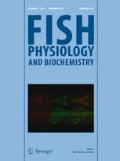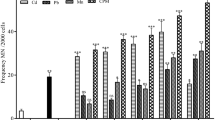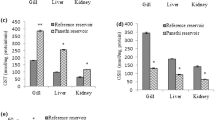Abstract
Hospital effluents contain myriad of mutagens and genotoxins capable of increasing DNA damage in aquatic biota. African mudfish, Clarias gariepinus, are exposed to genotoxins when cultured in swamps and derelict water bodies often contaminated by effluents. Moreover, its DNA is susceptible to xenobiotic-induced lesions since it lacks l-gulonolactone oxidase and hence cannot synthesize l-ascorbic acid. This study investigated 96-h acute toxicity and protective effects of dietary ascorbic acid (AA) against micronucleus (MN) and abnormal nuclear (NAs) formation in C. gariepinus exposed to sub-lethal concentrations of hospital effluent. Six concentrations (0.5–3.0%) of the effluent were selected to determine the 96-h acute toxicity of the effluent in C. gariepinus, after range finding test. Fish were exposed to sub-lethal concentrations (0.08–1.30%) of the 96 h LC50. Two other groups were exposed to the 96 h LC50 (1.30%) of the effluent +50 and +100 mg/kg of dietary ascorbic for 7 days, and MN and NAs assessed in peripheral erythrocytes. The 96 h LC50 (1.30%) was 1.18 times more toxic than the 24 h LC50 (1.54%), indicating that the toxicity of the effluent increased with exposure duration. MN, nuclear bud, enucleated, fragmented nucleus (apoptosis), and necrotic erythrocytes significantly increase in effluent treated fish. Dietary AA reduced MN from 6.35-fold (1.30% treated group) to 3.72-fold (1.30% + 50 mg AA) and 3.54-fold (1.30% + 100 mg AA). Also, AA reduced total NAs from 2.26-fold (1.30%) to 1.40-fold (1.30% + 50 mg AA) and 1.06-fold (1.30% + 100 mg AA) compared to the control. Heavy metals and physicochemical parameters analyzed in the tested effluent possibly induced the mortality and cytogenotoxicity in C. gariepinus, and this was ameliorated by dietary AA.



Similar content being viewed by others
References
Adeogun AO, Chukwuka AV (2011) Effect of textile factory effluent on otolith and somatic growth parameters in Clarias gariepinus. Zool 9:70–77
Adeogun AO, Ibor OR, Chukwuka AV (2013) Acute toxicity of abattoir and saw-mill effluents to juvenile-sized Clarias gariepinus. Zool Ecol 23:53–57
Agboola OA, Fawole OO (2014) Chronic toxicity of pharmaceutical effluent to Clarias gariepinus (Burchell, 1822). Covenant J Physical Life Sci 1:27–42
Alabi OA, Shokunbi OS (2011) Toxicological effects of hospital wastewater using animal bioassays. Ann Biol Res 2:265–275
Alimba CG, Bakare AA (2016) In vivo micronucleus test in the assessment of cytogenotoxicity of landfill leachates in three animal models from various ecological habitats. Ecotoxicology 25:310–319
Alimba CG, Ajayi EO, Hassan T, Sowunmi AA, Bakare AA (2015a) Cytogenotoxicity of abattoir effluent in Clarias gariepinus (Burchell, 1822) using micronucleus test. Chinese J Biol 2015:1–6. doi:10.1155/2015/624524 Article ID 624524
Alimba CG, Saliu JK, Ubani-Rex OA (2015b) Cytogenotoxicity and histopathological assessment of Lekki lagoon and Ogun River in Synodontis clarias (Linnaeus, 1758). Toxicol Environ Chem 97:221–234
Alkaladi A, Nasr El-Deen AM, Afifi M, Abu Zinadah AO (2015) Hematological and biochemical investigations on the effect of vitamin E and C on Oreochromis niloticus exposed to zinc oxide nanoparticles. Saudi J Biol Sci 22:556–563
American Public Health Association (APHA) (2005) Standard methods for examination of water including bottom sediments and sludges. Standard Methods, 19th edn, p 874
American Society for Testing and Materials (ASTM) (2002) Standard guide for conducting acute toxicity tests on test materials with fishes, macro vertebrates and amphibians. E729/96. In Annual Book of ASTM standards, ASTM, Philadelphia, PA., 11.05, 179–200
Ayllon F, Garcia-Vazquez E (2000) Induction of micronuclei and other nuclear abnormalities in European minnow Phoxinus phoxinus and mollie Poecilia latipinna: an assessment of the fish micronucleus test. Mutat Res 467:177–186
Ayoola SO, Bassey BO, Alimba CG, Ajani EK (2012) Textile effluent induced genotoxic effects and oxidative stress in Clarias gariepinus. Pakistan J Biol Sci 15:804–812
Bagatini MD, Vasconcelos TG, Laughinghouse HD IV, Martins AF, Tedesco SB (2009) Biomonitoring hospital effluents by the Allium cepa L. test. Bull Environ Contam Toxicol 82:590–592
Bakare AA, Alabi OA, Gbadebo AM, Ogunsuyi OI, Alimba CG (2013) In vivo cytogenotoxicity and oxidative stress induced by electronic waste leachate and contaminated well water. Challenges 4:169–187
Bendich A, Machlin LJ, Scandurra O, Burton GW, Wayner DDM (1986) The antioxidant role of vitamin C. Adv Free Radic Biol Med 2:419–444
Biuki NA, Savari A, Mortazavi M, Zolgharnein H, Salamat N (2011) Accumulation and elimination of cadmium and lead in juvenile milkfish during sublethal exposure. Toxicol Environ Chem 93:2022–2033
Bolognesi C, Hayashi M (2011) Micronucleus assay in aquatic animals. Mutagenesis 26:205–213
Canli M, Ay Ö, Kalay M (1998) Levels of heavy metals (cd, Pb, cu, Cr and Ni) in tissue of Cyprinus carpio, Barbus capito and Chondrostoma regium from the Seyhan River, Turkey. Turk J Zool 22:149–157
Carrasco KR, Tibury KL, Myers MS (1990) Assessment of the piscine micronucleus test as an in situ biological indicator of chemical contaminant effects. Can J Fish Aquat Sci 47:2123–2136
Choi SW, Benzie IFF, Collins AR, Hannigan BM, Strain JJ (2004) Vitamins C and E: acute interactive effects on biomarkers of antioxidant defence and oxidative stress. Mutat Res 551:109–117
Cole DW, Cole R, Gaydos SJ, Gray J, Hyland G, Jacques ML, Powell-Dunford N, Sawhney C, Au WW (2009) Aquaculture: environmental, toxicological, and health issues. Int J Hygiene Environ Health 212:369–377
Daiwile AP, Naoghare PK, Giripunje MD, Rao PDP, Ghosh TK, Krishnamurthi K, Alimba CG, Sivanesan S (2015) Correlation of melanophore index with a battery of functional genomic stress indicators for measurement of environmental stress in aquatic ecosystem. Environ Toxicol Pharmacol 39:489–495
Ekhaise FO, Omavwoya BP (2008) Influence of hospital wastewater discharged from University of Benin Teaching Hospital (UBTH), Benin city on its receiving environment. American-Eurasian J Agric Environ Sci 4:484–488
Emmanuel E, Keck G, Blanchard JM, Vermande P, Perrodin Y (2014) Toxicological effects of disinfections using sodiumhypochlorite on aquatic organisms and its contribution to AOX formation in hospital wastewater. Environ Int 30:891–900
Fenech M (2007) Cytokinesis-block micronucleus cytome assay. PRO 2:1084–1104
Fenech M, Kirsch-Volders M, Natarajan AT, Surralles J, Crott JW, Parry J, Norppa H, Eastmond DA, Tucker JD, Thomas P (2011) Molecular mechanisms of micronucleus, nucleoplasmic bridge and nuclear bud formation in mammalian and human cells. Mutagenesis 26:125–132
Finney DJ (1952) Probit analysis. Cambridge University Press, Cambridge
Fracalossi DM, Allen ME, Yuyama LK, Oftedal OT (2001) Ascorbic acid biosynthesis in Amazonian fishes. Aquaculture 192:321–332
Giuliani F, Koller T, Würgler FE, Widmer RM (1996) Detection of genotoxic activity in native hospital wastewater by the umuC test. Mutat Res 368:49–57
Grummt T, Grummt HJ, Schott M (1993) Chromosomal aberrations in peripheral lymphocytes of nurses and physicians handling antineoplastic drugs. Mutat Res 302:19–24
Harabawy ASA, Ibrahim ATA (2014) Sublethal toxicity of carbofuran pesticide on the African catfish Clarias gariepinus (Burchell, 1822): Hematological, biochemical and cytogenetic response. Ecotoxicol Environ Safety 103:61–67
Harabawy ASA, Mosleh YYI (2014) The role of vitamins a, C, E and selenium as antioxidants against genotoxicity and cytotoxicity of cadmium, copper, lead and zinc on erythrocytes of Nile tilapia, Oreochromis niloticus. Ecotoxicol Environ Safe 104:28–35
Harada M (1995) Minamata disease: methylmercury poisoning in Japan caused by environmental pollution. Crit Rev Toxicol 25:1–24
Hayler GS (1993) Aspects of the biology and culture of the African catfish, Clarias gariepinus, (Burchell 1822) with particular reference to developing African countries. Research Advances in Aquaculture IV. Minor JF, Roberts, RJ (eds). pp 235–291
Hossaina MS, Santhanam A, Norulaini NAN, Omar AKM (2011) Clinical solid waste management practices and its impact on human health and environment- a review. Waste Manag 31:754–766
Jiraungkoorskul W, Sahaphong S, Kangwanrangsan N, Zakaria S (2008) The protective influence of ascorbic acid against the genotoxicity of waterborne lead exposure in Nile tilapia, Oreochromis niloticus (L.) J Fish Biol 73:355–366
Jolibois B, Guerbet M (2005) Evaluation of industrial, hospital and domestic wastewater genotoxicity with the salmonella fluctuation test and the SOS chromotest. Mutat Res 565:151–162
Kummerer K (2009) Antibiotics in the aquatic environment- a review -part II. Chemosphere 75:435–441
Lee J, Moniruzzaman M, Yun H, Lee S, Park Y, Bai SC (2016) Dietary vitamin C reduced mercury contents in the tissues of juvenile olive flounder, Paralichthys olivaceus exposed with and without mercury. Environ. Toxicol Pharmacol 45:8–14
Liehr JG, Roy D, Gladek A (1989) Mechanism of inhibition of estrogen-induced renal carcinogenesis in male Syrian hamster by vitamin C. Carcinogenesis 10:1983–1988
Machlin LJ, Bendich A (1987) Free radical tissue damage: protective role of antioxidant nutrients. FASEB J 1:441–445
Magdaleno A, Juárez AB, Dragani V, Saenz ME, Paz M, Moretton J (2014) Ecotoxicological and genotoxic evaluation of Buenos Aires City (Argentina) hospital wastewater. J Toxicol 2014:1–10
Malins DC, McCain BB, Landahl JT, Myers MS, Krahn MM, Brown DW, Chanm SL, Roubal WT (1988) Neoplastic and others diseases in fish in relation to toxic chemicals: an overview. Aquat Toxicol 11:43–67
Maluf SW, Erdtmann B (2000) Evaluation of occupational genotoxic risk in a Brazilian hospital. Genet Mol Biol 23:485–488
Mason CF (1996) Biology of freshwater pollution, 3rd edn. Addison Wesley Longman Limited, Longman group UK, p 355
Mesi A, Kopliku D (2015) The use of Allium cepa L. assay for toxicity bio-moritoring of hospital effluents—an Albanian case. Euro J Toxicol Sci 1–15
Mix MC (1986) Cancerous disease in aquatic animals and their association with environmental pollutants: a critical literature review. Mar Environ Res 20:1–141
Moreau R, Dabrowski K (1998) Fish acquired ascorbic acid synthesis prior to terrestrial vertebrate emergence. Free Radic Biol Med 25:989–990
Moreau R, Dabrowski K (2000) Biosynthesis of ascorbic acid by extant actinopterygians. J Fish Biol 57:733–745
NESREA (2011) National Environmental (Surface and Groundwater quality) Regulations. National Environmental Standards and Regulations Enforcement Agency
Nishikimi M, Yagi K (1991) Molecular basis for the deficiency in humans of gulonolactone oxidase, a key enzyme for ascorbic acid biosynthesis. Am J Clin Nutr 54:1203S–1208S
Nwakwuo GC, Abanobi OC, Abaraogu UJ, Uwalaka CH, Asonye IC (2014) Hospital waste generation and management practices in Owerri, Nigeria. Afr J Environ Sci Technol 8:623–632
Organization for Economic Cooperation and Development (OECD) (1992) Guidelines for testing of chemicals. Guideline no. 203: fish, acute toxicity test
Orias F, Perrodin Y (2013) Characterisation of the ecotoxicity of hospital effluents: a review. Sci Total Environ 454–455:250–276
Pathan TS, Sonawane DL, Khillare YK (2009) Toxicity and behavioural changes in freshwater fish Rasbora daniconius exposed to paper mill effluent. Botany Research International 2(4):263–266
Patra RC, Swarup D, Dwivedi SK (2001) Antioxidant effects of alpha tocopherol, ascorbic acid and L-methionine on lead induced oxidative stress to the liver, kidney and brain in rats. Toxicology 162:81–88
Pulido MD, Parrish AR (2003) Metal-induced apoptosis: mechanisms. Mutat Res 533:227–241
Sandnes K (1991) Vitamin C in fish nutrition—a review. Fiskeridirektoratets Skrifter Serie Ernœring 4:3–32
Sato K, Niki E, Shimasaki H (1990) Free radical-mediated chain oxidation of low density lipoprotein and its synergistic inhibition by vitamin E and vitamin C. Arch Biochem Biophys 279:402–405
Sharma P, Mathur N, Singh A (2012) Genotoxicity of health care waste waters: a review. Res J Chem Environ 16:116–124
Taju G, Abdul Majeed S, Nambi KSN, SarathBabu V, Vimal S, Kamatchiammal S, SahulHameed AS (2012) Comparison of in vitro and in vivo acute toxicity assays in Etroplussu ratensis (Bloch, 1790) and its three cell lines in relation to tannery effluent. Chemosphere 87:55–61
Tsakona M, Anagnostopoulou E, Gidarakos E (2007) Hospital waste management and toxicity evaluation: a case study. Waste Manag 27:912–920
United States Environmental Protection Agency (USEPA) (1996) Acid digestion of sediments, sludges and soils. Method-3050B.USEPA: Washington, DC
United States Environmental Protection Agency (USEPA) (2005) Aquatic Toxicity Information Retrieve AQUIRE aquatic toxicology database. Available: www.epa.gov/ecotox/accesse
United States Environmental Protection Agency (USEPA) (2006) Maximum permissible limit for effluents from wastewater. http://www.epa.gov/safewater/mcl.html
Verlhac V, Gabaudan J (1994) Influence of vitamin C on the immune system of salmonids. Aquac Fish Manag 25:21–36
Verlicchi P, Galletti A, Petrovic M, Barceló D (2010) Hospital effluents as a source of emerging pollutants: an overview of micropollutants and sustainable treatment options. J Hydrol 389:416–428
World Health Organisation (WHO) (1990) Environmental health criteria for methylmercury, Environmental Health Criteria 101, Geneva, p 144
Yamamoto Y, Sato M, Ikeda S (1978) Existence of L-gulonolactone oxidase in some teleosts. Bull Jpn Soc Sci Fish 44:775–779
Author information
Authors and Affiliations
Corresponding author
Ethics declarations
Conflict of interest
The authors declare that there are no conflicts of interest.
Rights and permissions
About this article
Cite this article
Alimba, C.G., Ajiboye, R.D. & Fagbenro, O.S. Dietary ascorbic acid reduced micronucleus and nuclear abnormalities in Clarias gariepinus (Burchell 1822) exposed to hospital effluent. Fish Physiol Biochem 43, 1325–1335 (2017). https://doi.org/10.1007/s10695-017-0375-y
Received:
Accepted:
Published:
Issue Date:
DOI: https://doi.org/10.1007/s10695-017-0375-y




